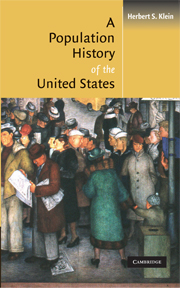Book contents
- Frontmatter
- Contents
- Graphs, Maps, and Tables
- Introduction
- 1 Paleo–Indians, Europeans, and the Settlement of America
- 2 Colonization and Settlement of North America
- 3 The Early Republic to 1860
- 4 The Creation of an Industrial and Urban Society, 1860–1914
- 5 The Evolution of a Modern Population, 1914–1945
- 6 The Baby Boom and Changing Family Values, 1945–1980
- 7 A Modern Industrial Society, 1980–2003
- Appendix: Tables, Graphs, and Maps
- Bibliography
- Index
6 - The Baby Boom and Changing Family Values, 1945–1980
Published online by Cambridge University Press: 05 June 2012
- Frontmatter
- Contents
- Graphs, Maps, and Tables
- Introduction
- 1 Paleo–Indians, Europeans, and the Settlement of America
- 2 Colonization and Settlement of North America
- 3 The Early Republic to 1860
- 4 The Creation of an Industrial and Urban Society, 1860–1914
- 5 The Evolution of a Modern Population, 1914–1945
- 6 The Baby Boom and Changing Family Values, 1945–1980
- 7 A Modern Industrial Society, 1980–2003
- Appendix: Tables, Graphs, and Maps
- Bibliography
- Index
Summary
If the pre–World War II period was one in which major changes in mortality and morbidity were most significant, the major theme in the immediate postwar period was one of significant fluctuations in fertility. In what would prove to be a temporary change in direction but with important long-term implications, the national population reversed its century-and-a-half-long secular decline in fertility and began moving toward higher birth rates. Yet by the end of this period, that trend would be reversed and replaced by startling new trends in both fertility and family organization. There were also changes in the intensity of the decline of mortality and morbidity and some interesting shifts in the ages experiencing declining rates due to the massive introduction of antibiotics. At the beginning of this period, foreign immigration reached its lowest point in over a century and yet, by the end of this era, immigration completely reversed its trend and a whole new chapter in the history of immigration to the United States began with the participation of new peoples populating the nation. This postwar period was also a time when internal patterns of migration began to clearly define some new and rather uniquely American patterns in urban settlement, with the rise of the suburbs and the corresponding changes in the inner cities. Finally, this was a period of the most intense African American migration, when the then-largest minority population in the national population ended its massive migration out of the South.
- Type
- Chapter
- Information
- A Population History of the United States , pp. 174 - 206Publisher: Cambridge University PressPrint publication year: 2004

